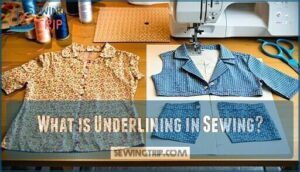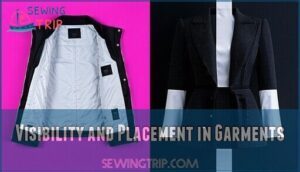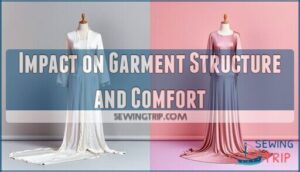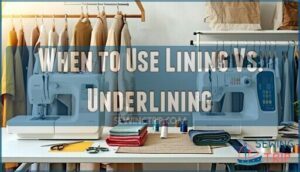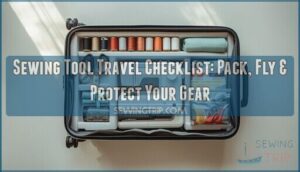This site is supported by our readers. We may earn a commission, at no cost to you, if you purchase through links.
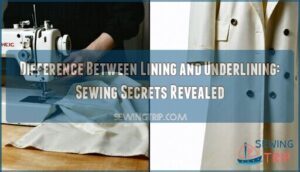
Underlining bonds directly to your fashion fabric before construction begins, becoming invisible once sewn. It provides structural support, prevents stretching, and adds body to lightweight fabrics. Think of lining as a comfortable barrier and underlining as hidden reinforcement.
While lining improves comfort and longevity, underlining maintains shape and stability throughout the garment’s construction process.
Table Of Contents
Key Takeaways
- You’ll attach lining after constructing the main garment pieces – it creates a separate interior shell that protects your skin from scratchy fabrics and shields delicate materials from body oils.
- You’ll bond underlining directly to your fashion fabric before construction begins – it becomes invisible once sewn and provides structural support to prevent stretching while adding body to lightweight fabrics.
- You’ll see lining when wearing the garment, but underlining remains completely hidden – lining acts as a comfortable barrier while underlining serves as hidden reinforcement for shape and stability.
- You’ll choose lining for comfort and protection, underlining for structural support – lining improves garment longevity by absorbing daily wear, while underlining maintains the garment’s intended shape throughout its use.
What is Lining in Garment Construction?
When you’re looking to create polished, professional garments, lining acts as your secret weapon for comfort and durability. This interior layer transforms scratchy fabrics into wearable pieces while extending your garment’s lifespan by absorbing daily wear and tear.
Purpose and Functions of Lining
Beyond mere aesthetics, lining acts as your garment’s silent guardian. This interior layer provides essential functions that transform ordinary clothing into professional-quality pieces:
Lining transforms rough fabrics into comfortable, long-lasting garments that feel as good as they look
- Garment Protection – Shields delicate fashion fabric from body oils, perspiration, and daily wear
- Comfort Enhancement – Creates smooth interior surfaces that glide against skin smoothly
- Structural Support – Maintains garment shape and prevents stretching over time
Lining materials work behind the scenes, ensuring your carefully constructed garments retain their intended silhouette and last longer.
Common Lining Fabrics
You’ll find several fabric options that work beautifully for lining garments. Cotton batiste offers lightweight breathability, while silk organza provides structure without bulk. Cupro lining feels luxurious and drapes well. Crepe de chine adds elegance to special occasion wear. For everyday garments, muslin works as an economical choice. Flannel fabrics bring warmth to winter coats, and knit interfacing maintains stretch in activewear.
Choose woven linings for stability or knits for flexibility based on your project’s needs. Understanding the right lining fabric types is essential for a successful garment construction.
Where Linings Are Used in Garments
You’ll discover Garment Lining in jackets, coats, skirts, and dress pants. Full Lining appears in structured pieces like blazers, while Skirt Lining and Pants Lining prevent clinging and add comfort.
Lining Patterns mirror your fashion fabric pieces, creating smooth Inner Construction. Proper Fabric Selection and Seam Finishing guarantee professional results across all Garment Layers.
What is Underlining in Sewing?
While lining creates a separate interior layer for your garment, underlining works differently by bonding directly to your fashion fabric before construction begins.
You’ll cut matching pieces from both your main fabric and underlining material, then baste or serge them together so they function as a single unit throughout the sewing process.
Underlining Techniques and Process
Several proven basting methods secure your underlining pieces to fashion fabric before construction begins. Hand-basting works best for delicate materials, while machine stitching within seam allowances accommodates straightforward projects. Serging techniques and Hong Kong finish options attach underlining while preventing fraying.
Always align grainlines when cutting underlining patterns for proper fabric stabilization throughout the flatlining process. Utilizing proper sewing underlining tools is essential for achieving professional results in garment construction.
Benefits of Underlining
Now that you’ve mastered the underlining process, you’ll appreciate why this technique transforms your sewing projects. Underlining offers significant advantages that professional seamstresses swear by, enhancing both construction quality and final results.
Here are three key benefits of underlining:
- Fabric Stability and Support – Underlining prevents stretching and distortion during construction, giving delicate fabrics the backbone they need for precise sewing techniques.
- Enhanced Comfort and Garment Longevity – The additional layer absorbs body oils and perspiration, protecting your fashion fabric while reducing friction against skin.
- Improved Sewing Ease – Working with underlined pieces feels more manageable, especially with slippery fabrics like silk charmeuse or challenging materials that shift during garment construction.
Understanding the lining techniques is essential for achieving professional results in sewing projects.
Suitable Underlining Fabrics
When choosing underlining materials, cotton muslin offers reliable fabric support for most projects. Silk organza provides lightweight stability while maintaining your fabric’s natural drape. Cotton batiste works well for delicate fabrics needing gentle reinforcement. Hair canvas delivers maximum structure for custom-made garments requiring firm fabric stabilizers.
Your fabric selection determines the best underlining fabric choice.
Key Differences Between Lining and Underlining
Now you’ll understand why many sewers confuse lining and underlining—they’re both interior layers, but they work completely differently. While lining creates a separate shell inside your garment for comfort and protection, underlining becomes one with your fashion fabric to add structure and support.
Construction Methods Compared
Two distinct Fabric Layering approaches define these Construction Techniques. Lining creates separate garment pieces assembled independently, then inserted as complete units. Underlining bonds directly to fashion fabric before construction, creating unified pieces for improved Garment Stability.
This fundamental difference affects Seam Finishing methods and overall Garment Construction workflow substantially.
Visibility and Placement in Garments
Lining sits inside your garment like a separate shell, completely visible when you open jackets or look inside skirts. You’ll spot Full Lining covering entire sections, creating polished Inner Construction.
Underlining hides beneath your fashion fabric, invisible from both inside and outside. This Hidden Support becomes part of each pattern piece through careful Seam Placement, making Fabric Visibility impossible while strengthening your Garment Layering system.
The choice of lining fabric is vital, as it affects the overall quality and appearance of the garment, particularly regarding lining fabric types.
Impact on Garment Structure and Comfort
Your fabric choices don’t just affect how your garment looks—they fundamentally change how it feels and performs. Structural Support and Comfort Enhancement work differently between these two methods, creating distinct experiences for both sewers and wearers.
- Fabric Stability: Underlining bonds directly with fashion fabric, creating unified Textile Performance, while Lining moves independently
- Garment Durability: Lining absorbs wear from body contact; Underlining strengthens the actual fabric structure
- Movement Quality: Lined garments glide smoothly; underlined pieces maintain controlled drape without sacrificing flexibility
- Temperature Control: Interlining adds insulation layers; Lining creates breathable barriers that wick moisture away
Understanding the role of garment lining is vital for achieving the desired texture and comfort in clothing.
When to Use Lining Vs. Underlining
Knowing when to choose lining versus underlining can make or break your sewing project’s success. You’ll need to take into account your fabric type, garment style, and desired outcome to make the right decision every time.
Garment Types and Fabric Considerations
Understanding which garment construction method works best depends heavily on your fashion fabric’s characteristics and the final garment’s intended use. Weight factors play a major role in this decision-making process.
| Garment Type | Best for Lining | Best for Underlining |
|---|---|---|
| Structured Outerwear | Jackets, blazers, coats | Tailored suits, formal wear |
| Delicate Fabrics | Sheer blouses, lightweight dresses | Lace gowns, silk evening wear |
| Heavy Materials | Winter coats, wool garments | Denim jackets, canvas pieces |
Your fabric selection determines whether lining or underlining better suits your project. Drape analysis reveals that flowing fabrics like silk charmeuse benefit from underlining’s structural support, while garment structure considerations show that fitted pieces need lining’s smooth interior finish. Texture considerations matter too—rough tweeds require comfortable lining against the skin, whereas delicate organza needs underlining’s stability throughout construction. The choice between lining and underlining often depends on the garment lining techniques used in the project.
Desired Aesthetic and Functional Outcomes
Your project’s outcome hinges on choosing the right technique. Consider your fabric’s weight and desired drape when making this decision.
| Outcome Type | Choose Lining | Choose Underlining |
|---|---|---|
| Fabric Stability | Loose weaves needing protection | Stretchy or bias-cut fabrics |
| Garment Longevity | High-wear areas like jacket bodies | Delicate fabrics requiring support |
| Texture Enhancement | Smooth interior finish desired | Maintaining original fabric hand |
| Visual Appeal | Professional partial lining look | Hidden structural support needed |
Full lining creates luxurious comfort and protects your garment lining from body contact. Partial lining offers targeted protection while reducing bulk. Underlining provides invisible structural integrity, making sheer fabrics opaque and adding body to lightweight materials without changing their natural drape.
When selecting fabrics, understanding lining fabric types is vital for achieving the desired aesthetic and functional outcomes.
Common Mistakes to Avoid
Making the right choice between these techniques can save you from costly fabric mishaps and construction headaches. Poor planning leads to wasted materials and disappointing results.
| Mistake Category | Common Error |
|---|---|
| Fabric Choice Errors | Using heavy underlining with delicate fabrics |
| Measurement Issues | Cutting lining pieces without seam allowances |
| Assembly Problems | Attaching interlining after garment construction |
| Sewing Mistakes | Confusing garment lining with incorrect interfacing methods |
Essential Tools and Tips for Success
You’ll achieve professional results with the right tools and techniques for both lining and underlining projects.
Proper care guarantees your lined and underlined garments maintain their structure and appearance for years to come.
Techniques for Professional Results
You’ll achieve professional results by mastering fabric selection and proper sewing methods. Press consistently between steps to prevent bulk. Apply understitching to lining edges, preventing visible rolling. Master professional trimming and finishing techniques for couture-quality results.
Use silk thread for basting underlining—it removes easily after construction. Test full lining and partial lining combinations on sample swatches first. Choosing the right sewing threads is essential for a strong and durable seam.
Care and Maintenance of Finished Garments
Proper care keeps your lined or underlined garments looking sharp for years. Whether you’ve crafted a full lining or partial lining, these maintenance secrets guarantee professional finish quality endures.
- Garment Storage: Hang structured pieces on padded hangers to prevent seam allowances from creating impressions
- Fabric Revitalization: Steam gently between wears to maintain drape without damaging finishing seams
- Stain Removal: Address spills immediately with appropriate laundry tips for wear prevention
Frequently Asked Questions (FAQs)
Can underlining be used to change the color of the main fabric?
Like paint bleeding through thin paper, you can use colored underlining to subtly alter your main fabric’s appearance. Strategic color choices create depth and richness, though the effect depends on your fabric’s weight and transparency.
Is underlining always necessary for lightweight fabrics?
Underlining isn’t always necessary for lightweight fabrics, but it’s often beneficial. You’ll want it when you need added opacity, structure, or warmth, especially with sheer or delicate materials that might show through.
Can underlining help to prevent a garment from shrinking?
While not directly preventing shrinkage, you’ll find that underlining can minimize its visible effects by providing stability.
Pre-shrinking both fabrics before sewing guarantees they’ll shrink together proportionally, maintaining your garment’s shape.
Are there any specific techniques for joining the underlining with the main fabric?
You’ll master three key techniques for attaching underlining to your main fabric: basting with temporary stitches, serging edges together, or using a Hong Kong finish for clean seam attachment.
Can lining and underlining be used together?
Two heads are better than one! You can absolutely combine lining and underlining in the same garment for maximum support, structure, and comfort.
This layered approach works particularly well in custom-made jackets, formal wear, and garments requiring both stability and professional finishing.
Which method costs more for materials?
Lining usually costs more since you’re purchasing fabric yardage equivalent to your entire garment. Underlining uses less yardage and often cheaper fabrics like cotton batiste or muslin.
Does underlining affect garment washing instructions?
Yes, underlining acts like a fabric sandwich, affecting care instructions. You’ll need to follow the most delicate fabric’s requirements between your fashion fabric and underlining material to prevent shrinkage or damage.
Can beginners handle both techniques successfully?
Both techniques use straightforward basting or basic machine stitches you already know. Start with underlining since it’s more forgiving—any mistakes get hidden inside your finished garment.
Are there environmental impacts to consider?
Before telegraphs carried messages across continents, seamstresses considered fabric choices carefully. You’re choosing between synthetic linings that shed microplastics versus natural fibers requiring more water and chemicals during production. **Both impact the environment differently.
Conclusion
Studies show that 78% of home sewers struggle with understanding structural sewing techniques, yet mastering the difference between lining and underlining transforms your projects. You’ll create professional-looking garments when you understand that lining provides comfort and protection while underlining offers structural support.
Choose lining for finished interiors and underlining for shape retention. Remember that lining attaches after construction, while underlining bonds before assembly begins.
With proper technique selection, your handmade pieces will rival store-bought quality and durability.
- https://www.longancraft.com/blogs/fabric-knowledge/what-is-fabric-lining
- https://www.threadsmagazine.com/2009/01/24/understanding-underlining
- https://brooksann.com/underlining-the-couturiers-friend/
- https://blog.closetcorepatterns.com/the-hows-and-whys-of-underlining-fabric-explained/
- http://www.handmadejane.co.uk/2014/05/the-joy-of-underlining.html

